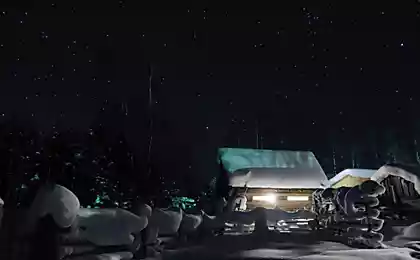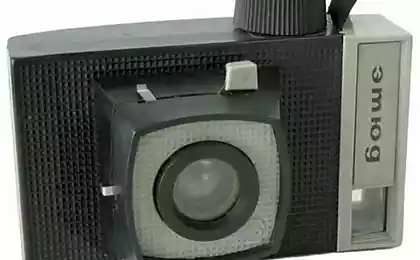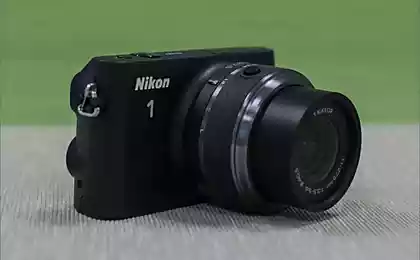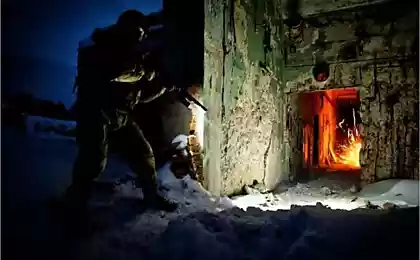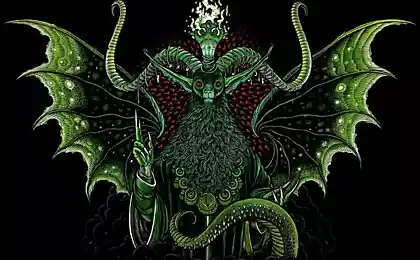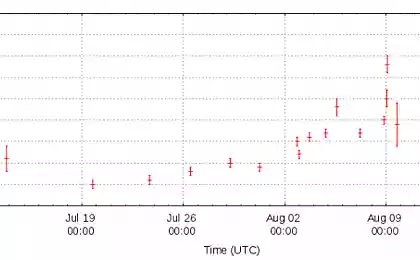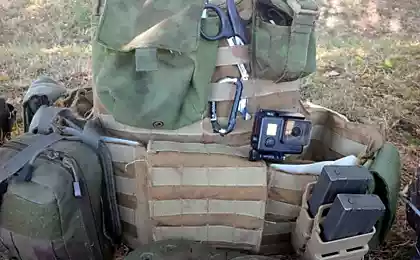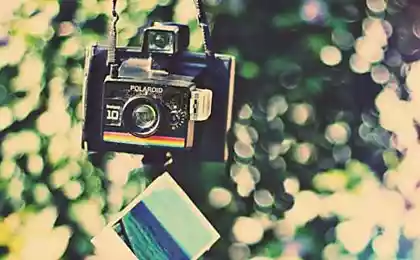814
Photographic yore
Just wanted to say a few words about why I created a topic, what information it provided and that I plan to post here in the future. First of all, I would like to arrange a small but beloved collection of photographic equipment. In my hobby, I do not stick to what that system, the collection chamber that I like or something interesting. Therefore, the information will be primarily on them. Basically, this inexpensive camera and maybe someone will want to collect similar collection.
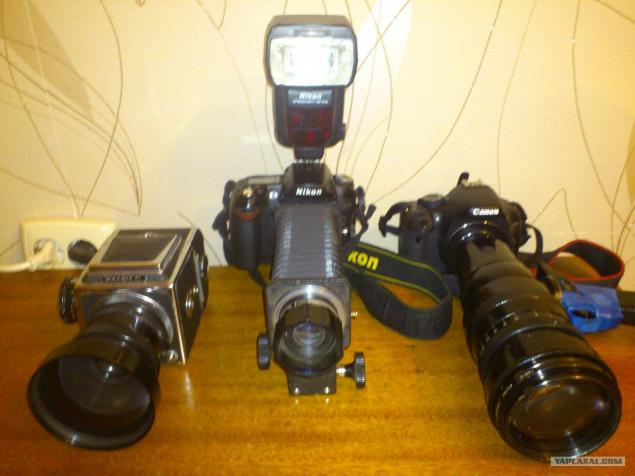
He was the first in my collections, and so he opens the parade.
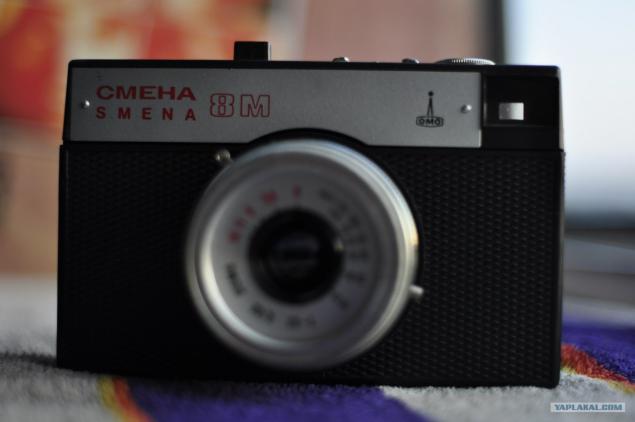
this camera has got virtually thanks
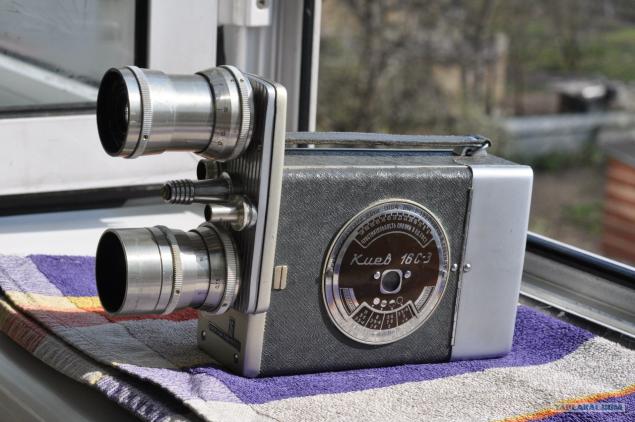
The latest model line camera bar-graph "Change". In comparison with the previous model, "Change-8m" improved viewfinder, he became the optical and moved closer to the lens, which reduces parallax. Shutter setting lever and rewind the film makes it impossible to re-exposure frame. Trigger the gate of the lens on the front side wall of the chamber. Tape rewind.
There were no casualties. With the lens barrel disappeared depth of field scale. It is not clear what guided the developers. Perhaps they did not want to confuse the novice photographer plenty of numbers on the lens barrel. But it was the presence of the depth of field scale relieves stress for novice camera bar-graph associated with the determination of the distance to the subject. It quickly becomes convinced that because of the large depth of field in the wide-angle lens need for precise determination of the distance is eliminated.
Out of the situation is to use a table depth of field.
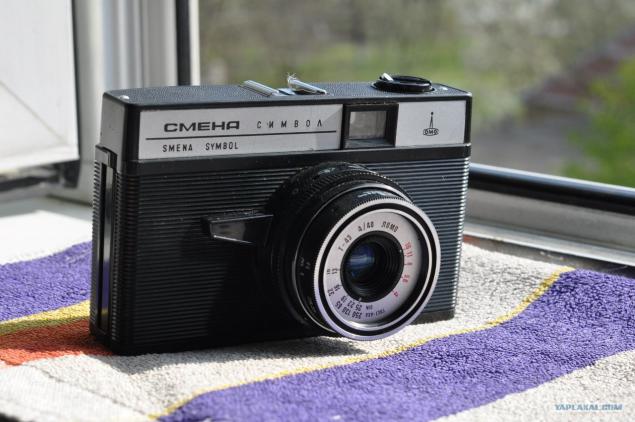
with the obektivom refused to work. but with all the others to cheer.

"Kiev-19", 1985-1991 gg
Small-format SLR with a semi-automatic exposure control for TTL system when the real (installed on the scale of the lens) Aperture.
Designed for amateur photography.
The camera is designed for use of photographic film 35 mm wide in the standard magazines.
Completed aperture lens MC HELIOS-81H 2/50, providing high quality images in various lighting conditions.
A large mirror, high-aperture sight, the universal focusing device ensure accurate focusing staff and interchangeable lenses.
The range of shutter speed: 1/500 - 1/2 and "B"; Dimensions without lens: 147h100h55; weight (without case) is not more than 1 kg.
Issue I - the name of the camera in Russian
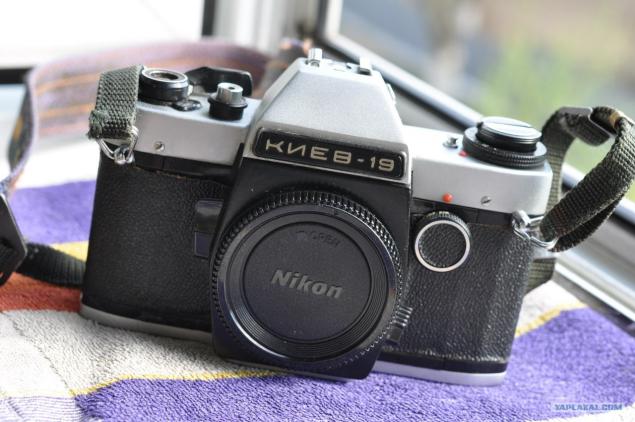
Babe of the miracle of personal roskazat can not.
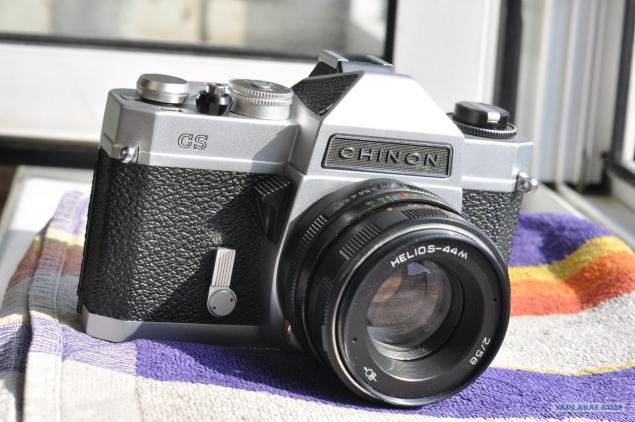
Still quite a rare thing. vipuschenno about 3500 thousand. pieces
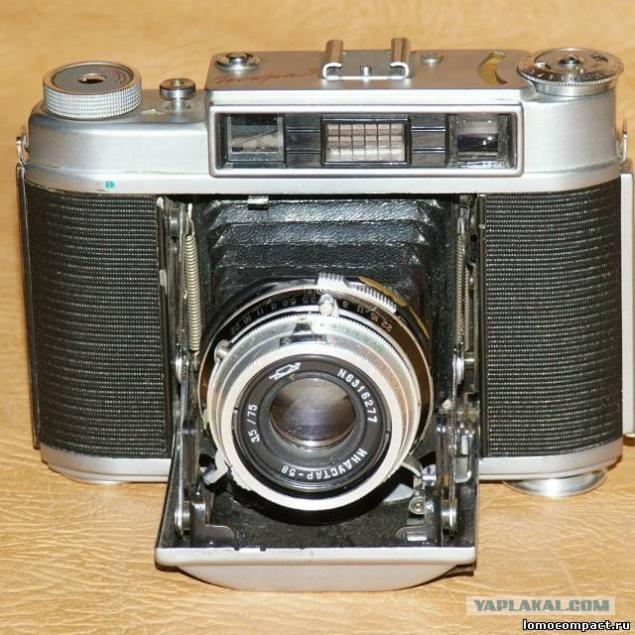
FED-Micron - Soviet barchart half-frame camera, manufactured from 1968 to 1985 at the Kharkov machine-building plant "FED".
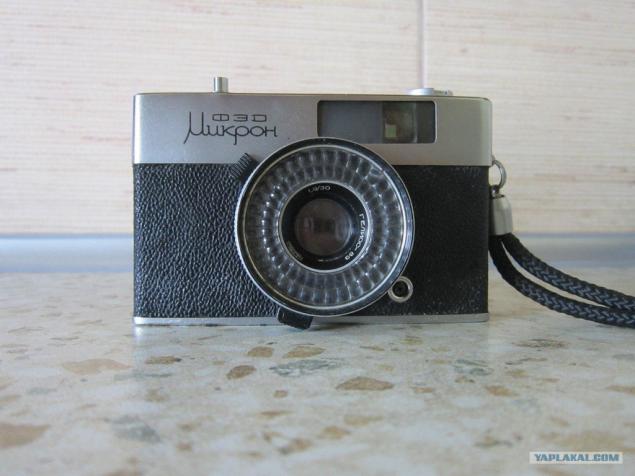
Here is such a small Screen)

"LOMO-135VS" 1975-1982 gg
The camera had a built-in spring mechanism for automatic shutter cocking and film rewinding - a spring charging enough for 8 frames. It is supplied with the lens' Industar-73 "2, 8/40 (4 ling
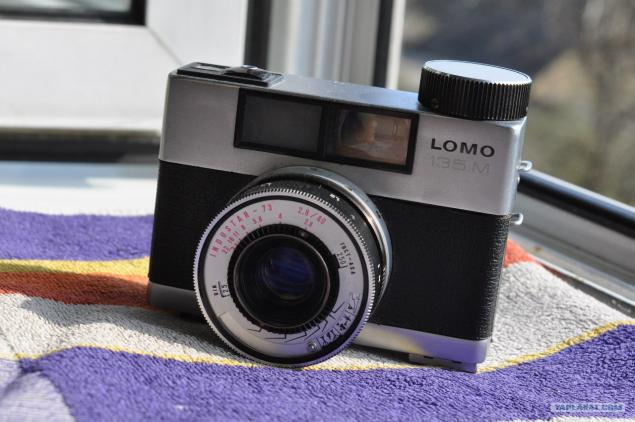
The original machine.

The frame size of 36 × 24 mm. Charging 35mm photographic film in a standard tape capacity 36 shots.
Lens' Industar-70 "2, 8/50, nonremovable. Lens made of lanthanum glass and have an amber illumination. The lens is made by the scheme Tessar (four lenses in three groups). It differs from all lenses "Industar" that the two-lens component is directed to the subject, rather than photographic film [1]. There is a built-in lens hood. Carving a 58 mm filter.
Focus with rangefinder with a base of 67 mm. Focus range from 0, 8 m to infinity. Focus is turning inside of the front two-lens component, the rotation angle of 90 degrees.
Viewfinder Optical, bright, with a large field of view, combined with a range finder, a highlighted frame and automatic parallax compensation vertically and horizontally.
Shutter - central, mezhdulinzovy, shutter 1/30, 1/60, 1/125, 1/250, 1/500 sec and "B».
Aperture five-petal mezhdulinzovaya. Aperture value 2, 8, 4, 5, 6, 8, 11, 16.
Shutter cocking lever interlocked with the film rewind and the frame counter.
When nevzvedёnnom gate setting shutter speed and aperture is prohibited (is blocked). Failure to follow these instructions causes damage to the gate. There is a partial blockage of the shutter cocking.
The bottom cover of the camera is a button to rewind and the frame counter. When you open the rear wall of the frame counter is reset automatically.
Rewind crank - roulette, located on the side of the unit.
There is a clip for connecting the flash sync type "X" and "M", the central sync - only the camera "Sokol-2" only electronic flash unit ("X»).
Power supply automatic exposure metering - disk nickel-cadmium accumulator D-0, 06 [2] or mercury battery RC-53 [3] (the modern equivalent of the PX-625 [4]), has control of the power supply.
In the absence of power supply the camera is fully operational in manual
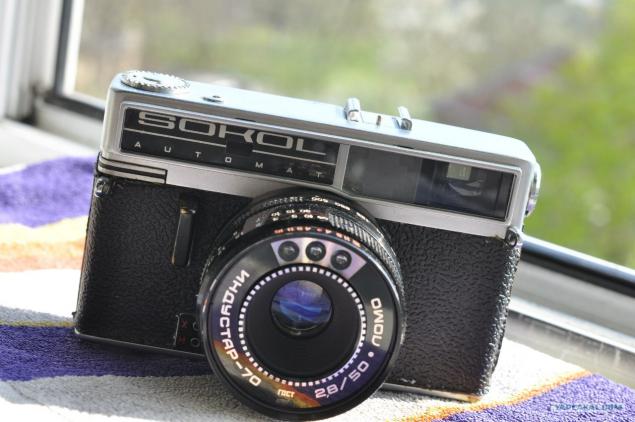
In 1913 Oskar Barnack, an employee of the company Leitz, Germany (now Leica Camera) constructed a prototype small-format camera designed for shooting at later became widespread perforated 35-mm film. The camera has a frame size of 24 × 36 mm (twice as much as the film frame).
In 1925 started the production of small-format camera bar-graph «Leica I», since 1932, started producing the world's first small-format rangefinder camera «Leica II» («Leica D») with the ability to change lenses.
In 1934 a copy of «Leica II» began producing in Kharkov factory labor communes named Felix Dzerzhinsky (later the Kharkov machine-building plant "FED"). Title Soviet camera "FED" - an abbreviation of the name of Felix Dzerzhinsky.
«Leica II» («Leica D»)
(1932-1948)
"FED»
(1934-1955)
After World War II the technical documentation on the camera transferred to the Krasnogorsk Mechanical Plant.
Since 1948, started production in Krasnogorsk camera - almost an exact copy of the first "FEDa." Krasnogorskie first cameras were called "FED" logo ASM until 1949 - "FED 1948 Sharp" in 1950 - "Sharp».
The name "Sharp" is derived from the telegraph address KMZ produced during the war, defense products. Later this name was the same for all the plant rangefinder cameras (except for the "others").

Here all elementary. This lighter
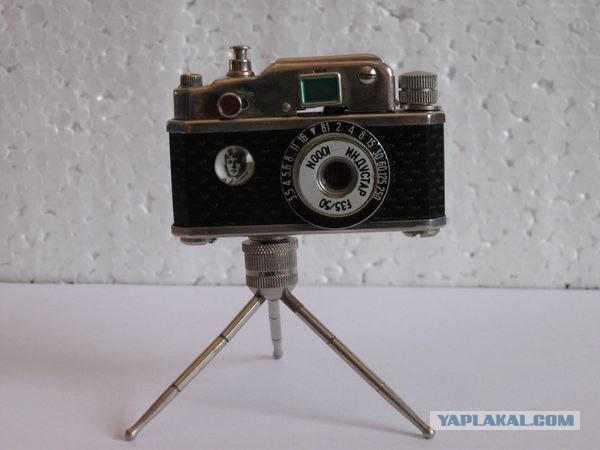
Sharp-10 & quot ;, 1964-1978 gg
Semi-automatic rangefinder camera with lens zhёstkovstroennym "Industar-63" 2, 8/45, having a central shutter with shutter speeds from 1/30 to 1/500, V. was equipped with a photographic exposure meters, located on the front of the lens. Sensitivity from 16 to 250 units. GOST. It was possible to turn off automatic aperture and shoot manually at full aperture and shutter speed to 1/30. Viewfinder magnification - 0, 65h, the base rangefinder - 38mm. To signal a lack of lighting in the field of view has a red stripe. Automatic counter shows the number of remaining shots. The camera also differed over an unusual arrangement cocking - at the bottom of the front panel. 332144 units were produced. Issue I - the name of the device in Russian.
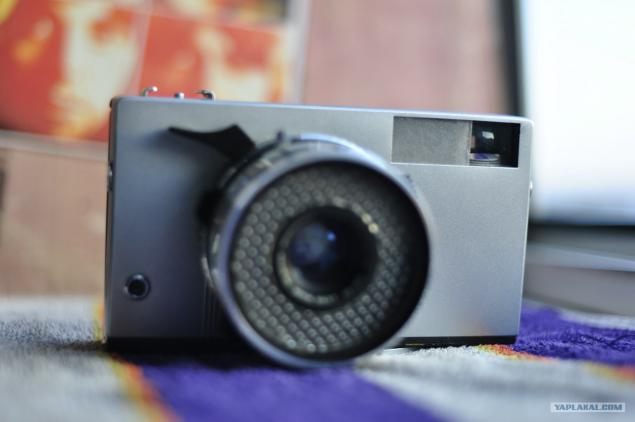
"Sharp-4K", 1972-1978 and 1980. GG
Option "4K" was cocking the shutter. They were produced 524,646 units. In 1980, the remnants of the backlog of parts were assembled 36 vehicles. Issue I - the name of the device in Russian.

Likon-35S - Soviet small-format camera automatically bar graph of a family of unified camera with built-in flash units (production BelOMO).
It produced a modified model "Elikon-35cm" with the ability to manually set the aperture.
This family includes cameras "Elikon-3", "4-Elikon" having some structural differences (type of lens, a method of exposure).
On the basis of the camera "Elikon-35C" was created the first Soviet apparatus with autofocus "Elikon-AF».
In chambers "Elikon" was first applied in the USSR built flash.
The prototype camera "Elikon-35S" is known as "Orion-35s."
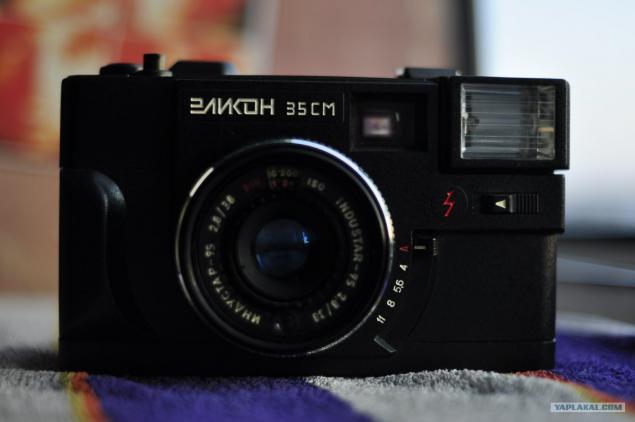
Source:

He was the first in my collections, and so he opens the parade.

this camera has got virtually thanks

The latest model line camera bar-graph "Change". In comparison with the previous model, "Change-8m" improved viewfinder, he became the optical and moved closer to the lens, which reduces parallax. Shutter setting lever and rewind the film makes it impossible to re-exposure frame. Trigger the gate of the lens on the front side wall of the chamber. Tape rewind.
There were no casualties. With the lens barrel disappeared depth of field scale. It is not clear what guided the developers. Perhaps they did not want to confuse the novice photographer plenty of numbers on the lens barrel. But it was the presence of the depth of field scale relieves stress for novice camera bar-graph associated with the determination of the distance to the subject. It quickly becomes convinced that because of the large depth of field in the wide-angle lens need for precise determination of the distance is eliminated.
Out of the situation is to use a table depth of field.

with the obektivom refused to work. but with all the others to cheer.

"Kiev-19", 1985-1991 gg
Small-format SLR with a semi-automatic exposure control for TTL system when the real (installed on the scale of the lens) Aperture.
Designed for amateur photography.
The camera is designed for use of photographic film 35 mm wide in the standard magazines.
Completed aperture lens MC HELIOS-81H 2/50, providing high quality images in various lighting conditions.
A large mirror, high-aperture sight, the universal focusing device ensure accurate focusing staff and interchangeable lenses.
The range of shutter speed: 1/500 - 1/2 and "B"; Dimensions without lens: 147h100h55; weight (without case) is not more than 1 kg.
Issue I - the name of the camera in Russian

Babe of the miracle of personal roskazat can not.

Still quite a rare thing. vipuschenno about 3500 thousand. pieces

FED-Micron - Soviet barchart half-frame camera, manufactured from 1968 to 1985 at the Kharkov machine-building plant "FED".

Here is such a small Screen)

"LOMO-135VS" 1975-1982 gg
The camera had a built-in spring mechanism for automatic shutter cocking and film rewinding - a spring charging enough for 8 frames. It is supplied with the lens' Industar-73 "2, 8/40 (4 ling

The original machine.

The frame size of 36 × 24 mm. Charging 35mm photographic film in a standard tape capacity 36 shots.
Lens' Industar-70 "2, 8/50, nonremovable. Lens made of lanthanum glass and have an amber illumination. The lens is made by the scheme Tessar (four lenses in three groups). It differs from all lenses "Industar" that the two-lens component is directed to the subject, rather than photographic film [1]. There is a built-in lens hood. Carving a 58 mm filter.
Focus with rangefinder with a base of 67 mm. Focus range from 0, 8 m to infinity. Focus is turning inside of the front two-lens component, the rotation angle of 90 degrees.
Viewfinder Optical, bright, with a large field of view, combined with a range finder, a highlighted frame and automatic parallax compensation vertically and horizontally.
Shutter - central, mezhdulinzovy, shutter 1/30, 1/60, 1/125, 1/250, 1/500 sec and "B».
Aperture five-petal mezhdulinzovaya. Aperture value 2, 8, 4, 5, 6, 8, 11, 16.
Shutter cocking lever interlocked with the film rewind and the frame counter.
When nevzvedёnnom gate setting shutter speed and aperture is prohibited (is blocked). Failure to follow these instructions causes damage to the gate. There is a partial blockage of the shutter cocking.
The bottom cover of the camera is a button to rewind and the frame counter. When you open the rear wall of the frame counter is reset automatically.
Rewind crank - roulette, located on the side of the unit.
There is a clip for connecting the flash sync type "X" and "M", the central sync - only the camera "Sokol-2" only electronic flash unit ("X»).
Power supply automatic exposure metering - disk nickel-cadmium accumulator D-0, 06 [2] or mercury battery RC-53 [3] (the modern equivalent of the PX-625 [4]), has control of the power supply.
In the absence of power supply the camera is fully operational in manual

In 1913 Oskar Barnack, an employee of the company Leitz, Germany (now Leica Camera) constructed a prototype small-format camera designed for shooting at later became widespread perforated 35-mm film. The camera has a frame size of 24 × 36 mm (twice as much as the film frame).
In 1925 started the production of small-format camera bar-graph «Leica I», since 1932, started producing the world's first small-format rangefinder camera «Leica II» («Leica D») with the ability to change lenses.
In 1934 a copy of «Leica II» began producing in Kharkov factory labor communes named Felix Dzerzhinsky (later the Kharkov machine-building plant "FED"). Title Soviet camera "FED" - an abbreviation of the name of Felix Dzerzhinsky.
«Leica II» («Leica D»)
(1932-1948)
"FED»
(1934-1955)
After World War II the technical documentation on the camera transferred to the Krasnogorsk Mechanical Plant.
Since 1948, started production in Krasnogorsk camera - almost an exact copy of the first "FEDa." Krasnogorskie first cameras were called "FED" logo ASM until 1949 - "FED 1948 Sharp" in 1950 - "Sharp».
The name "Sharp" is derived from the telegraph address KMZ produced during the war, defense products. Later this name was the same for all the plant rangefinder cameras (except for the "others").

Here all elementary. This lighter

Sharp-10 & quot ;, 1964-1978 gg
Semi-automatic rangefinder camera with lens zhёstkovstroennym "Industar-63" 2, 8/45, having a central shutter with shutter speeds from 1/30 to 1/500, V. was equipped with a photographic exposure meters, located on the front of the lens. Sensitivity from 16 to 250 units. GOST. It was possible to turn off automatic aperture and shoot manually at full aperture and shutter speed to 1/30. Viewfinder magnification - 0, 65h, the base rangefinder - 38mm. To signal a lack of lighting in the field of view has a red stripe. Automatic counter shows the number of remaining shots. The camera also differed over an unusual arrangement cocking - at the bottom of the front panel. 332144 units were produced. Issue I - the name of the device in Russian.

"Sharp-4K", 1972-1978 and 1980. GG
Option "4K" was cocking the shutter. They were produced 524,646 units. In 1980, the remnants of the backlog of parts were assembled 36 vehicles. Issue I - the name of the device in Russian.

Likon-35S - Soviet small-format camera automatically bar graph of a family of unified camera with built-in flash units (production BelOMO).
It produced a modified model "Elikon-35cm" with the ability to manually set the aperture.
This family includes cameras "Elikon-3", "4-Elikon" having some structural differences (type of lens, a method of exposure).
On the basis of the camera "Elikon-35C" was created the first Soviet apparatus with autofocus "Elikon-AF».
In chambers "Elikon" was first applied in the USSR built flash.
The prototype camera "Elikon-35S" is known as "Orion-35s."

Source:

